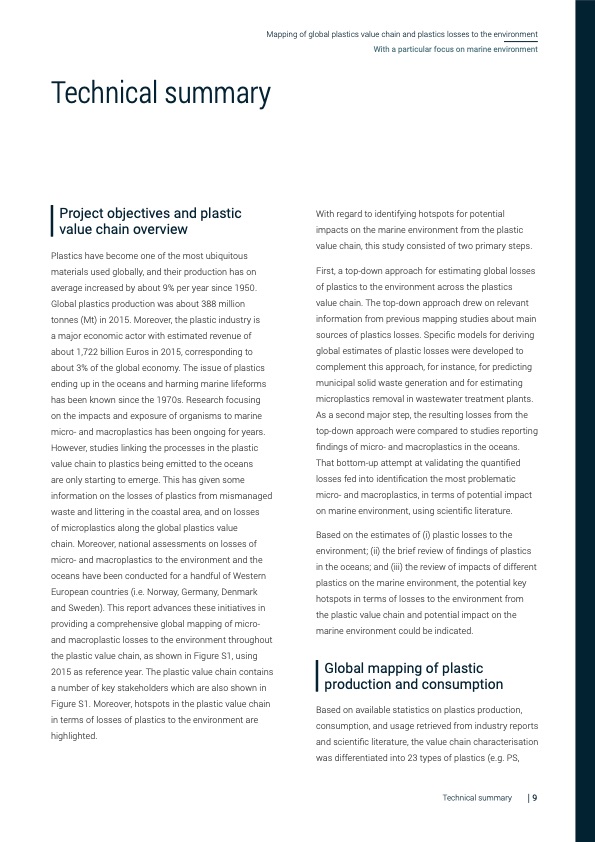
PDF Publication Title:
Text from PDF Page: 011
Technical summary | Project objectives and plastic value chain overview Plastics have become one of the most ubiquitous materials used globally, and their production has on average increased by about 9% per year since 1950. Global plastics production was about 388 million tonnes (Mt) in 2015. Moreover, the plastic industry is a major economic actor with estimated revenue of about 1,722 billion Euros in 2015, corresponding to about 3% of the global economy. The issue of plastics ending up in the oceans and harming marine lifeforms has been known since the 1970s. Research focusing on the impacts and exposure of organisms to marine micro- and macroplastics has been ongoing for years. However, studies linking the processes in the plastic value chain to plastics being emitted to the oceans are only starting to emerge. This has given some information on the losses of plastics from mismanaged waste and littering in the coastal area, and on losses of microplastics along the global plastics value chain. Moreover, national assessments on losses of micro- and macroplastics to the environment and the oceans have been conducted for a handful of Western European countries (i.e. Norway, Germany, Denmark and Sweden). This report advances these initiatives in providing a comprehensive global mapping of micro- and macroplastic losses to the environment throughout the plastic value chain, as shown in Figure S1, using 2015 as reference year. The plastic value chain contains a number of key stakeholders which are also shown in Figure S1. Moreover, hotspots in the plastic value chain in terms of losses of plastics to the environment are highlighted. With regard to identifying hotspots for potential impacts on the marine environment from the plastic value chain, this study consisted of two primary steps. First, a top-down approach for estimating global losses of plastics to the environment across the plastics value chain. The top-down approach drew on relevant information from previous mapping studies about main sources of plastics losses. Specific models for deriving global estimates of plastic losses were developed to complement this approach, for instance, for predicting municipal solid waste generation and for estimating microplastics removal in wastewater treatment plants. As a second major step, the resulting losses from the top-down approach were compared to studies reporting findings of micro- and macroplastics in the oceans. That bottom-up attempt at validating the quantified losses fed into identification the most problematic micro- and macroplastics, in terms of potential impact on marine environment, using scientific literature. Based on the estimates of (i) plastic losses to the environment; (ii) the brief review of findings of plastics in the oceans; and (iii) the review of impacts of different plastics on the marine environment, the potential key hotspots in terms of losses to the environment from the plastic value chain and potential impact on the marine environment could be indicated. | Global mapping of plastic production and consumption Based on available statistics on plastics production, consumption, and usage retrieved from industry reports and scientific literature, the value chain characterisation was differentiated into 23 types of plastics (e.g. PS, Mapping of global plastics value chain and plastics losses to the environment With a particular focus on marine environment Technical summary | 9PDF Image | Mapping of global plastics value chain

PDF Search Title:
Mapping of global plastics value chainOriginal File Name Searched:
2018-plastics-global-hotspots.pdfDIY PDF Search: Google It | Yahoo | Bing
Development of a solar powered Electric Ship The Electricship website originally started off as a project to develop a comprehensive renewable, affordable, modular electric ship... More Info
Modular Boat Hull Composite The case for a unsinkable, modular composite hybrid boat hull... More Info
MS Burgenstock Hybrid Electric Catamaran Lake Lucerne Unique shuttle servicing Lucerne to the Burgenstock Resort... More Info
Ground Power Unit GPU Powered by Lithium Ion Batteries The goal of the Ground Power Unit is to provide a readily accessible, modular, ready-to-power solution for remote power... More Info
| CONTACT TEL: 608-238-6001 Email: greg@electricship.com | RSS | AMP |